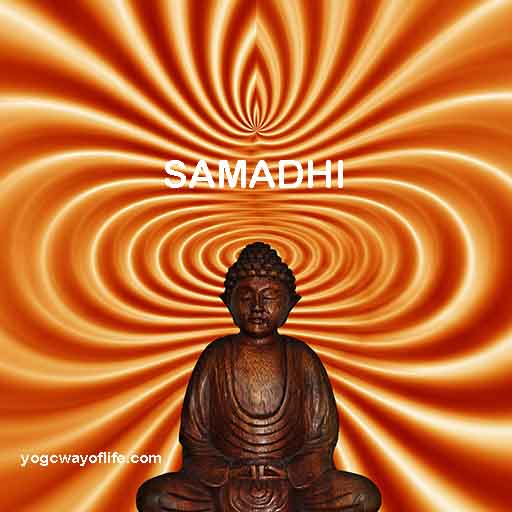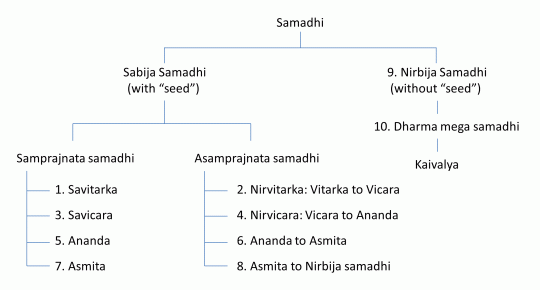Samadhi in Yoga is the 8th and final stage or step in the system of eight-limbed Ashtanga Yoga. Samadhi is explained in the Yoga Sutras of Maharishi Patanjali as total absorption in the object of meditation, where the mind becomes completely still. There are various stages of Samadhi each leading to a higher super conscious state of mind.

In the 8-fold path of yoga, Samadhi is considered among the internal limbs of yoga (along with Dharana and Dhyana). The internal limbs of yoga are part of Raja Yoga or the royal path to liberation.
In Patanjali Yoga Sutras, Samadhi is defined as “tad eva artha matra nirbhasam svarupa shunyam iva samadhih”
Here tad means that; and Eva means only or the same.
Artha means object or place or point.
Matra means only or alone.
Nirbhasam means shines forth.
Svarupa means own nature or form.
Shunyam means nothingness or empty or devoid of.
Iva means as it were; Samadhi means deep absorption.
So Samadhi in Yoga can be translated as – “When the essence of the object of meditation alone shines forth, as if devoid even of its own form, that deep state of absorption it is called Samadhi”.
In Dharana (concentration) and Dhyana (meditation), there exists the observer, observed and the process of observing. It can also be understood as the knower, known and the process of knowing. In state of Samadhi, this distinction ceases to be. It is as if, only the object of meditation remains. In this state of deep absorption, duality vanishes.
How to practice Samadhi in Yoga?
Samadhi cannot be practiced. It happens spontaneously just like meditation. There is no effort involved. One cannot forcefully practice Samadhi. We have to start from the process of Dharana or concentration with effort and in due course of time experience Dhyana or state of meditation, which occurs spontaneously. In Dharana (concentration), there is focus and effort and in Dhyana (meditation) there is de-focus, relaxation and effortlessness. In Samadhi, there is a sudden jump from the state of Dhyana or meditation into a state of total absorption in the object of meditation, where the knower, knowing and known merges into one conscious reality. This is totally effortless. Samadhi is an experience of super conscious state of mind. It can be compared to deep sleep, except that, in deep sleep we are not conscious, while in Samadhi one is fully conscious.
TYPES OF SAMADHI IN YOGA
Patanjali Yoga Sutras describe various types of Samadhi. The experience of a meditator goes from gross to the subtle, from external to the internal. Each stage of Samadhi is a progression into our own inner true reality, which is beyond name and form. With each stage, the experience is subtler and subtler. In the initial stages, our inner impressions or habitual mental formations or Vasanas remain. These stages are classified under Sabija Samadhi. Bija means seed. In Sabija Samadhi, the seed of inner impressions remain. After due practice, these impressions get wiped out. Then one reaches the seedless state of Nirbija Samadhi or the seed-less state. From the Nirbija stage, the final state of liberation or Kaivalya is just a small step away.
It is difficult to explain each stage of Samadhi in yoga in detail. But given below is a simplified explanation of each stage.
SABIJA SAMADHI IN YOGA
All stages of Samadhi, where the inner impressions of the mind are still functioning are classified under Sabija Samadhi. There are four stages of Sabija Samadhi – Tarka, Vichara, Ananda and Asmita, each representing a progressively subtler form of our inner existence. In Sabija Samadhi, when there can be a particular “content of mind” called Pratyaya, which can be an object, thought, feeling, etc.; then, it is grouped under Samprajnata Samadhi. The content disappears when you transition from one stage to another. Those stages are grouped under Asamprajnata Samadhi or Samadhi without any content of mind. A broad description is given below of all the above said stages:
SAMPRAJNATA SAMADHI
- Samvirtarka Samadhi – When content of mind involves gross objects or particulars.
- Samvichara Samadhi – When content of mind involves subtler mental impressions.
- Ananda – When content of mind involves the feeling of bliss from inside.
- Asmita – When content of mind involves the feeling of individuality or the “I” sense only.
ASAMPRAJNATA SAMADHI
- Nirvirtarka Samadhi – Stage of transition from Samvitarka to Samvichara
- Nirvichara Samadhi – Stage of transition from Samvichara to Ananda
- Transition from Ananda to Asmita
- Transition from Asmita to Nirbija Samadhi
NIRBIJA SAMADHI IN YOGA
Nirbija means “without a seed”. In Nirbija Samadhi, there is no Pratyaya or content of mind, as the inner impressions or Vasanas of the Chitta (total mind impressions) has been purified by earlier stages of practice. This leads to the next stage of Dharma Megha Samadhi.
DHARMA MEGHA SAMADHI
Megha means Cloud and Dharma means virtue. At this stage the yogi has gone beyond the principles governing the cosmos. The creation is made of 24 Tattvas, according to Sankhya Philosophy. All these Tattvas exist because of Prakriti supported by the three Gunas – Sattva, Rajas and Tamas. In Dharma Megha Samadhi, the yogi becomes free from the three Gunas and identifies himself with Purusha or the supreme reality. He is beyond all the powers; and is full of bliss, purity and knowledge. From Dharma Megha Samadhi comes the end of all afflictions and karma. The yogi reaches the ultimate stage of Kaivalya or complete liberation.
A representative chart of the above states of Samadhi is given below:

Courtesy: /https://dondeg.wordpress.com/2014/05/28/patanjalis-ten-types-of-samadhi/

Hi ,
This is a very useful article – I think this full stage of yoga can only be conceptualised by someone who has a physical yoga practise & a long term, regular spiritual Bhakti yoga practise.
I found it quite relevant – but only because I could just piece the meanings together based on my own personal experience – which has been over 12 years in the making